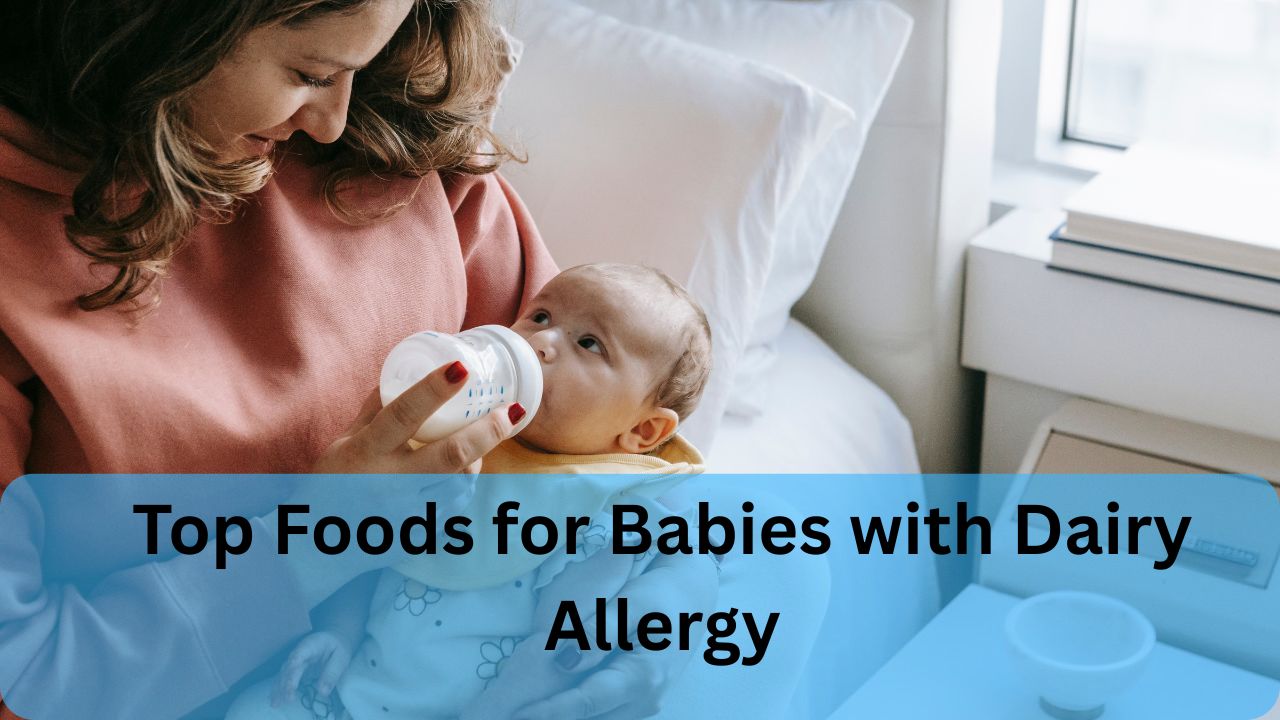Navigating meals for a baby with a dairy allergy can feel overwhelming—but with the right guidance, you can ensure they get complete nutrition without worry. In this 2025 guide, we’ll explain how to identify a dairy allergy, recommend smart substitutes for milk and yogurt, suggest essential nutrients to watch, and share allergy-safe recipes, feeding tips, and expert advice—all while keeping feeding fun, convenient, and nutritious.
Read-Baby Shower Food Ideas: Delicious Menu for 2025
Recognizing a Dairy Allergy in Infants
A true dairy allergy—a reaction to dairy proteins like casein or whey—can show up with symptoms such as hives, vomiting, diarrhea, blood in the stool, or breathing difficulties. These reactions typically occur within minutes to a few hours after consuming cow’s milk or any dairy-containing food. If you suspect an allergy, speak with a pediatrician or pediatric allergist for testing and a tailored diet plan.
Also Read
Safe Milk Substitutes for Infants
If your baby is allergic to dairy, selecting a suitable replacement for breast milk or cow’s-milk formula is vital. Soy-based infant formula (when fortified) is a widely accepted alternative by pediatricians for full-term infants. On the other hand, rice-based formulas or extensively hydrolyzed and amino acid formulas are available through prescription when multiple allergies or intolerances are at play. For babies over 12 months, fortified plant milks—such as unsweetened soy, oat, or pea—are possible options; ensure they contain calcium, vitamin D, and protein.
Dairy-Free Solid Foods & Key Nutrients
Once solids begin (usually around six months), these dairy-free foods help meet essential nutrient needs:
✅ Protein-Rich Choices
-
Legumes: Mashed peas, lentils, chickpeas
-
Meat, Poultry & Fish: Lean minced turkey, chicken, mashable fish like salmon or cod—rich in iron and omega-3 fatty acids
-
Tofu & Soft Beans: Great sources of plant-based protein
✅ Healthy Fats
-
Avocado, olive oil, nut butters (if allowed), and ground flaxseed help with brain and eye development
✅ Calcium & Vitamin D
-
Calcium-fortified plant milks
-
Tofu set with calcium sulfate
-
Green veggies like kale and spinach (best if pureed)
-
Fortified cereals & juices
✅ Vitamin B12 & Iodine
-
Fortified foods or a baby-safe multivitamin may be necessary—especially for vegan or predominantly plant-based diets
Dairy-Free Recipe Ideas
Here are some balanced and yummy options:
Iron-Rich Lentil & Sweet Potato Mash
-
Cook red lentils and sweet potato until tender
-
Blend with olive oil, sprinkle cinnamon or mild herbs
Berry-Oat Breakfast Mash
-
Combine cooked oats with mashed berries and fortified plant milk
-
Stir in ground flaxseed for omega-3s
Protein-Packed Quinoa Bowl
-
Mix cooked quinoa with pureed veggies, avocado, and minced meat or beans
Vegan Tofu “Cheese” Spread
-
Blend silken tofu with nutritional yeast, garlic powder, salt, and herbs—great on toast or veggie dippers
Allergy Management & Monitoring
-
One new food at a time: Introduce new items with 3–5 days in between to monitor reactions
-
Careful with cross-contamination: Avoid shared utensils, toaster use, or prep surfaces touching dairy
-
Label everything when away from home to prevent accidental exposure
-
Keep antihistamines nearby after talking to your healthcare provider—first aid is important
✅ Professional Advice and Trusted Tips
The American Academy of Pediatrics recommends a cautious, monitored approach when feeding infants with milk allergy, particularly during solid-food introduction. They also note the importance of growth tracking and nutrient supplementation as needed. This guidance ensures your baby’s dietary needs are fully met despite dairy limitations.
Frequently Asked Questions
1. Is lactose intolerance the same as dairy allergy?
No—lactose intolerance stems from enzyme deficiency, while a dairy allergy is an immune reaction to milk proteins. Allergy tends to be more serious and requires strict avoidance.
2. Can I give almond or coconut milk to an infant?
Not as a sole milk source. These plant milks are inadequate for infants due to low protein or insufficient calories.
3. Is yogurt a good alternative?
Yes—but use unsweetened plant-based yogurts fortified with calcium and vitamin D.
4. When can my baby try dairy again?
Many infants outgrow cow’s milk allergy by age 3–5; always have reintroduction under medical supervision.
5. Should I consider a specialist formula?
If your baby has multiple food allergies or growth issues, extensively hydrolyzed or amino acid-based formulas may be prescribed.
Avoiding Hidden Dairy
Always read labels carefully. Dairy can be present in unexpected forms, such as “caseinate,” whey, butterfat, or lactose—in products like baked goods, processed meats, sauces, and snacks. If you’re ever uncertain, verify with manufacturers or check certification logos like “dairy free” or “vegan.”
✅ Conclusion
Feeding a baby with a dairy allergy in 2025 doesn’t have to be stressful. By choosing allergy-safe milk alternatives, protein- and nutrient-rich foods, and monitoring meals diligently, you can support healthy growth and a happy feeding experience. Armed with smart meal ideas, allergy awareness, and professional guidance, you’ll confidently nourish your dairy-free little one.





